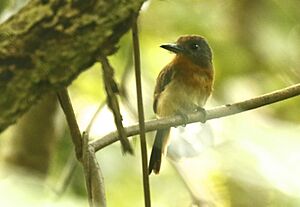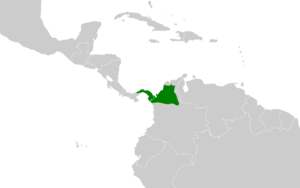Grey-cheeked nunlet facts for kids
Quick facts for kids Grey-cheeked nunlet |
|
|---|---|
 |
|
| Alginate area - Darien, Panama | |
| Conservation status | |
| Scientific classification | |
| Genus: |
Nonnula
|
| Species: |
frontalis
|
 |
|
The grey-cheeked nunlet (Nonnula frontalis) is a small, interesting bird found in the forests of Colombia and Panama. It belongs to a family of birds called Bucconidae, which includes puffbirds, nunlets, and nunbirds. These birds are known for their quiet behavior and often sit still for a long time, waiting for insects.
Contents
About This Bird's Family
Scientists first officially described the grey-cheeked nunlet in 1854. This happened in Colombia. There are three main types, or subspecies, of the grey-cheeked nunlet. These are N. f. frontalis, N. f. stulta, and N. f. pallescens.
Sometimes, scientists think that one of these types, N. f. pallescens, might be a subspecies of another bird. That bird is the rufous-capped nunlet. The grey-cheeked nunlet is also closely related to the rufous-capped nunlet and the chestnut-headed nunlet.
What Does It Look Like?
The grey-cheeked nunlet is about 14 to 15 centimeters (5.5 to 6 inches) long. It weighs between 14.5 and 19.5 grams (about 0.5 to 0.7 ounces).
The top of its head is a very dark chestnut color. Its upper body is plain brown, becoming lighter near its tail. Most of its face is gray. It has a ring of bare red skin around its dark brown eyes. The tail is dark brown, almost black at the tip.
Its chin, throat, chest, and sides are a reddish-brown color. Its belly is a light yellowish-brown. The bird's beak is mostly blue-gray. Its feet are a dull brown or greenish-gray.
Different types of grey-cheeked nunlets have slight differences. For example, N. f. stulta has a darker head. Its tail is blacker than the main type. N. f. pallescens has much paler upper parts. Its throat and chest are a lighter yellowish-brown.
Where Does It Live?
The grey-cheeked nunlet lives in a specific area. This area stretches from central Panama to north-central Colombia.
The N. f. stulta type lives in the northernmost part of this range. You can find it from central Panama into the very northwest of Colombia. The N. f. pallescens type lives in the lowlands of northern Colombia, near the Caribbean Sea. The main type, N. f. frontalis, lives more inland in northern Colombia.
This bird likes many different kinds of places. It lives in moist or humid forests. These can be old, untouched forests or forests that have grown back. It also likes forests along rivers and thick bushes. It especially prefers woodlands near water.
The grey-cheeked nunlet usually stays in the lower parts of the forest. However, it can sometimes be seen higher up, almost to the top of the trees. It lives from sea level up to about 1,000 meters (3,300 feet) high.
How It Behaves
What It Eats
Scientists have not fully studied how the grey-cheeked nunlet finds its food. However, it has been seen eating many different kinds of arthropods. Arthropods are creatures like insects and spiders. Sometimes, this bird will join groups of different bird species. These groups forage, or search for food, together.
Reproduction
The grey-cheeked nunlet lays eggs and raises its young from February to June in Colombia. Not much else is known about how it breeds. In general, scientists do not know a lot about the nesting habits of the Nonnula genus. This is the group of birds that nunlets belong to.
However, a related bird, the rusty-breasted nunlet, builds a shallow nest. It covers its nest with small twigs and leaves. This species usually lays four eggs at a time.
Its Song
The grey-cheeked nunlet's song is a sad, slow series of notes. It can sing up to 20 notes in a row. It sounds like "weeip weeip, weeip..."
How Many Are There?
The IUCN (International Union for Conservation of Nature) has looked at the grey-cheeked nunlet. They have listed it as a species of "Least Concern." This means it is not currently in danger of disappearing.
However, its population is estimated to be fewer than 50,000 adult birds. This number is also decreasing. The species is considered uncommon or rare in Panama. But it is generally quite common in Colombia.


